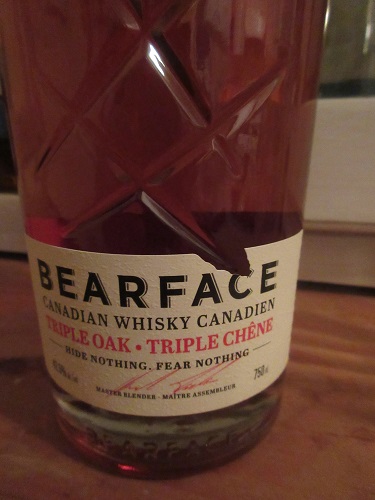Next time you are at your local liquor store you may notice a new product – Bearface Canadian Whisky.

I first saw this stuff back at Christmas in an Ontario LCBO Store.
I have since been busy piecing together the puzzle. Here is what I have found:
This Whisky was actually made on the shores of Georgian Bay. Hence, I have to assume it was made by Collingwood Distillers in Ontario, who are owned by Brown Foreman, the parent company of the Jack Daniels brand. Collingwood makes its base Whisky from western Canadian barley according to the book Whisky – The Portable Expert by D. DeKergommeaux.
After 6 years of ageing, a quantity of this Collingwood Whisky was then sold to Mission Hill Vineyards in Kelowna, BC. The six year old distillate seems to have been then divided into three portions. One portion was added to ex-bourbon barrels, one portion to ex-red wine casks and one portion to Hungarian Oak casks. After one more year of ageing, these barrelled portions were blended together, proofed to 40% and bottled as a 7 year old product.
The bottle bears the scratch markings of a bear and even the label has a wee tear in it for added authenticity. In the world of Canadian Whisky – don’t forget that marketing is everything. And what is more authentic in Canada than using a bear as your marketing symbol?
I have now had a chance to
evaluate this product. I followed my usual protocol of first diluting my
dram to 30% so I could evaluate the aroma. I noted slight evidence of
pears and fruit which would be the ethyl acetate
molecules in the liquid acting on my olfactory senses.
Next I added more water to take the dilution to 20% where I turned focus to the mouthfeel and structure. This is where disappointment set in. You see, Canadian Whisky is largely made on column stills which by their very
design strip out much of the flavor from the distillate. Contrast this to Scotch or Irish Whisky where pot stills are used to retain body and flavor.
Bearface in my opinion lacks body, backbone and texture. I will admit though that it is a smooth dram and on the otherwise long finish I could detect a slight bit of what I thought was red wine (from the ex-wine casks) and a bit of spice (possibly from the Hungarian oak casks or possibly from any rye grain used to make the Whisky).
I immediately followed up this taste test with a dram of no age statement Glenlivet Scotch where I was immediately reminded (and refreshingly so…) what body, texture and backbone feel like on the palate.
If I had to assign a numerical score to Bearface, I would rate it only 80 out of 100. I have no doubt that you will soon see the so-called experts release their glowing descriptions and high numerical ratings of Bearface describing how they can taste buttterscotch candies, fresh mown hay and Unicorn tears. That is entertainment fodder for the masses. Don’t be fooled.
On a related note, this experience speaks to what I have been long saying in the 5 Day Distillery Workshops. And that message is – forget trying to make Whisky on a column still. The Canadian market is drowning in Whisky made on column stills where the flavor and character has been stripped away. Craft distillers who have been unwittingly sold a column still, are only adding to the over-supply problem. If craft distillers want to do something unique, they ought to be using the double pot distillation process as is custom in Scotland and Ireland. If you are a craft distiller reading this post and if you are using the pot distillation process, then I wholeheartedly salute you! Consumers in Canada have a long standing habit of mixing their Whisky with cola or ginger ale. If that is your wont,then Bearface is something you can buy. But if you want a dram that you can sip after adding only a tiny bit of water, then there are better products on the shelf to look at.



